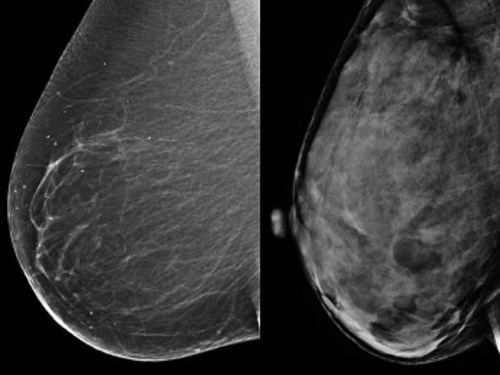If you have breasts like this you could be at risk of cancer

Amber Whalan was just 28 years old and pregnant when she found a lump on her breast. Naturally, she went to have it checked, but the technician was unable to make a diagnosis due to her breast tissue being so dense. It wasn’t until she had an MRI scan it was revealed that the lump was cancerous.
And Whalan isn’t the only one. An estimated 2 million women around the country have dense breasts, putting them at a higher risk of developing cancer – five times more likely, in fact.
But what are dense breasts and how can you tell if you have them? As ABC explains, breasts are made from a combination of glandular, fatty and fibrous tissue – but no two women have the same composition of each. Some are fattier, while others are more fibrous. It’s that concentration of fibrous tissue which indicates “dense breasts”.

Image credit: Massachusetts General Hospital/ABC News.
Because dense tissue appears as white on a mammogram (the same colour as tumours and other abnormalities), it makes it almost impossible for technicians to spot an issue.
Unfortunately, you can’t tell for yourself if you have dense breasts by looking or feeling, and neither can your doctor. The only way to identify density is through a mammogram.
According to breast cancer charity Pink Hope, around 83 per cent of Australian women don’t know if they have dense breasts or not, and four out of five had no idea that dense breasts carried an increased risk of cancer.
It’s believed that up to 50 per cent of Aussie women between the ages of 40 and 74 have dense tissue, and unfortunately, there’s nothing you can do about it. However, your breast tissue does become less dense with age.
If you have concerns about your breasts or simply want to know if you’re at risk, take action and organise a mammogram.
